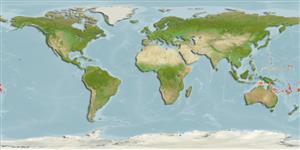Klassifizierung / Names
Namen | Synonyme | Catalog of Fishes(Gattung, Arten) | ITIS | CoL | WoRMS | Cloffa
>
Gobiiformes (Gobies) >
Gobiidae (Gobies) > Gobiinae
Etymology: Trimma: Greek, trimma, -atos = something crushed (Ref. 45335); anthrenum: From the Greek word 'anthrene', a wild bee, wasp or hornet, referring to its aposematic coloration of yellow with black stripes..
More on author: Winterbottom.
Environment: milieu / climate zone / depth range / distribution range
Ökologie
seewasser riff-verbunden; tiefenbereich 5 - 76 m (Ref. 57544). Tropical
Western Pacific: Fiji and Tonga.
Size / Gewicht / Alter
Maturity: Lm ? range ? - ? cm
Max length : 2.0 cm SL Männchen/unbestimmt; (Ref. 57544); 2.0 cm SL (female)
Rückenflossenstacheln (insgesamt): 7; Rückenflossenweichstrahlen (insgesamt): 8-9; Afterflossenstacheln 1; Afterflossenweichstrahlen: 7 - 9. Diagnosis: Characterized by the presence of scales in the predorsal midline; second and third dorsal spines either slightly or not elongate; an unbranched fifth pelvic fin ray; both interorbital and postorbital trenches moderately well developed; and the absence of opercular scales. Scale margins of preserved specimens are very finely outlined with melanophores across the top half of the body, which is otherwise almost devoid of visible pigment cells. When alive, it has a yellow body, and the iris has a pair of blue and black triangles with their bases against the anterior and posterior margins of the pupil (giving the pupil a slit-like appearance), the posterior triangle continues anteroventrally around the pupil margin. Both living and preserved specimens have a dark basal stripe in the medial fins and a blaze of brown pigment on the upper part of the pectoral-fin base (Ref. 57544).
Life cycle and mating behavior
Geschlechtsreife | Fortpflanzung | Ablaichen | Eier | Fecundity | Larven
Winterbottom, R., 2006. Two new species of the gobiid fish Trimma from the coral reefs of the western Pacific Ocean (Pisces; Perciformes; Gobioidei). Zootaxa 1331:55-68. (Ref. 57544)
IUCN Rote Liste Status (Ref. 130435)
Bedrohung für Menschen
Harmless
Nutzung durch Menschen
Mehr Information
NamenSynonymeMetabolismusRäuberÖkotoxikologieFortpflanzungGeschlechtsreifeAblaichenSpawning aggregationFecundityEierEientwicklung
Alter/GrößeWachstumLänge-GewichtLänge-LängeLängenhäufigkeitenMorphometrieMorphologieLarvenLarven Pop.Dyn.RekrutierungDichteBRUVS
ReferenzenAquakulturAquakultur ProfilZuchtlinienGenetikElectrophoresesVererbbarkeitKrankheitenVerarbeitungNutrientsMass conversion
PartnerBilderStamps, Coins Misc.LauteCiguateraGeschwindigkeitSchwimmstilKiemenoberflächeOtolithsGehirngrößeSehfähigkeit
Tools
Zusatzinformationen
Download XML
Internet Quellen
Estimates based on models
Preferred temperature (Ref.
123201): 25.4 - 28.7, mean 27.3 °C (based on 124 cells).
Phylogenetic diversity index (Ref.
82804): PD
50 = 0.5000 [Uniqueness, from 0.5 = low to 2.0 = high].
Bayesian length-weight: a=0.01023 (0.00477 - 0.02194), b=3.02 (2.84 - 3.20), in cm total length, based on LWR estimates for this (Sub)family-body shape (Ref.
93245).
Widerstandsfähigkeit (Ref.
120179): hoch, Verdopplung der Population dauert weniger als 15 Monate. (Preliminary K or Fecundity.).
Fishing Vulnerability (Ref.
59153): Low vulnerability (10 of 100).
